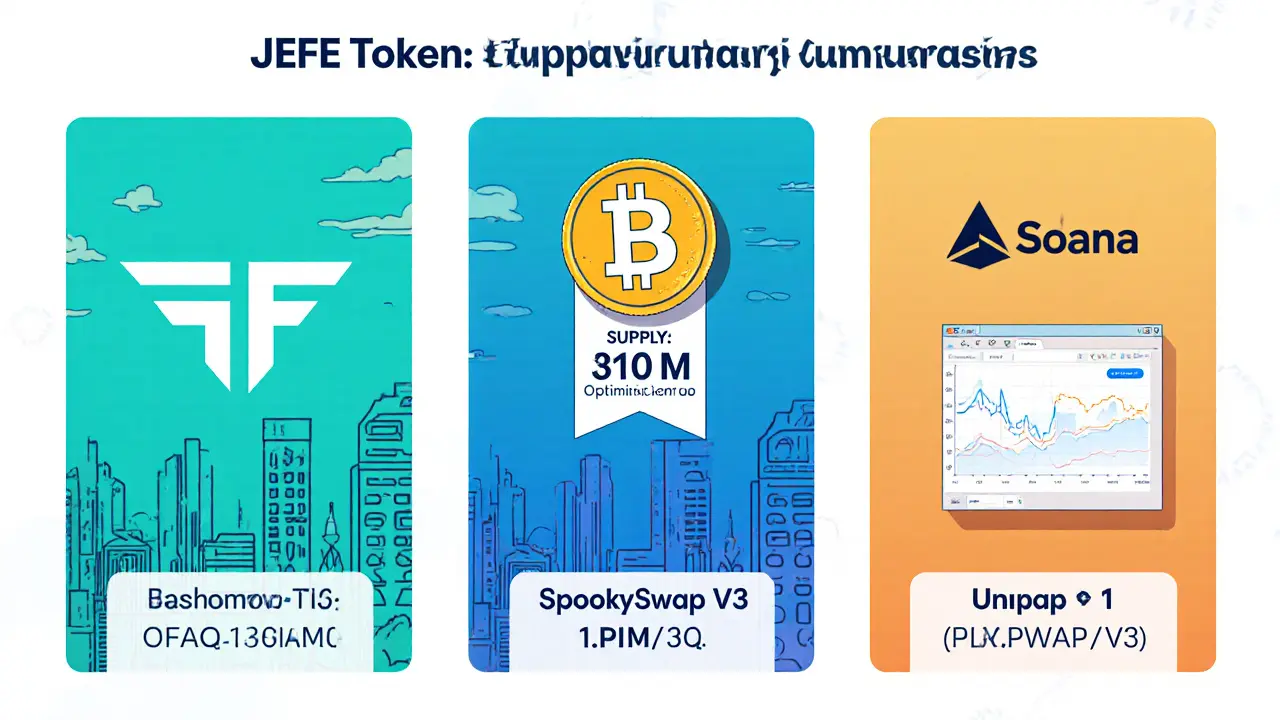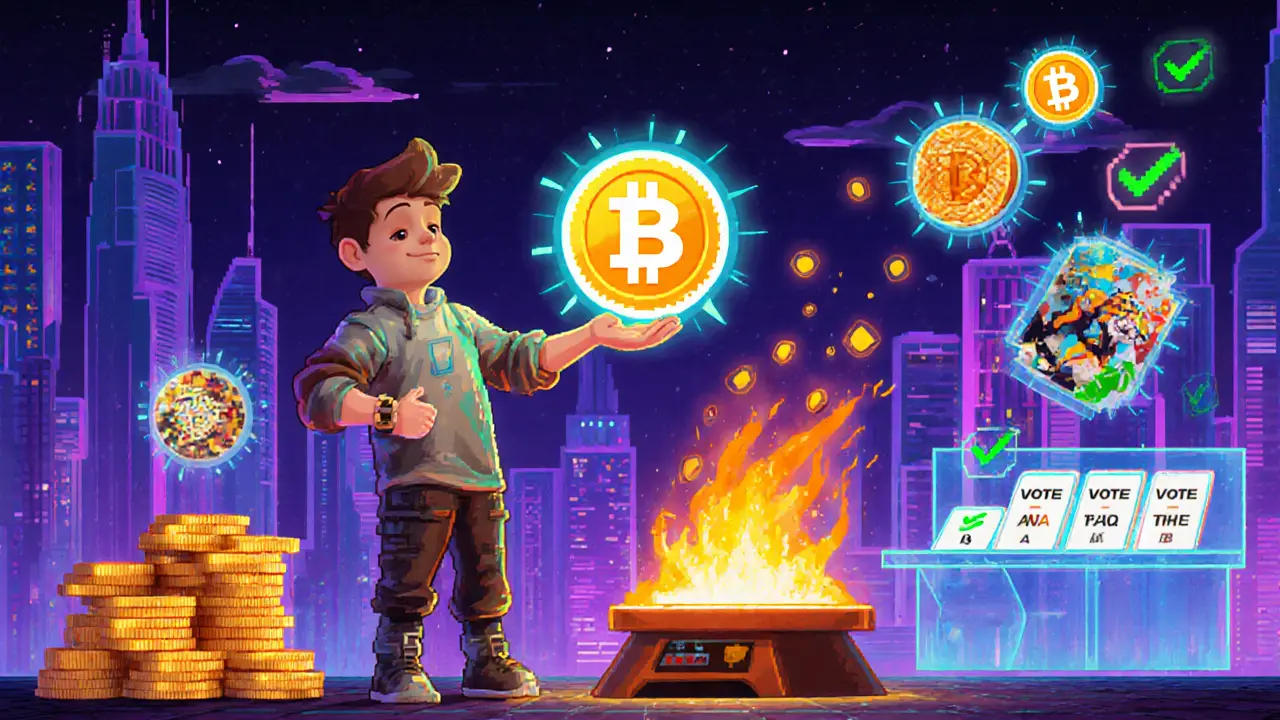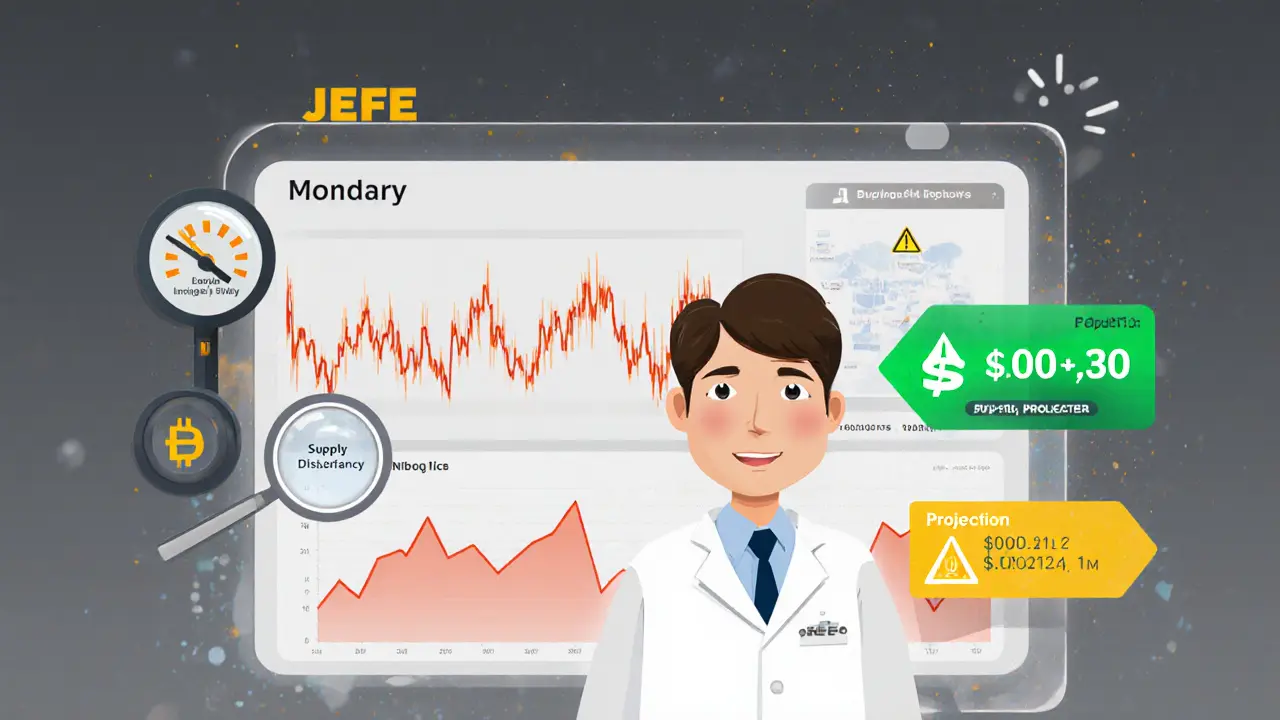JEFE Token (JEFE) Explained: Gaming Crypto, DAO, and Market Outlook

JEFE Token Supply & Chain Comparison
Fantom
Supply: 310M
Dex: SpookySwap V3
Use Case: Gaming NFTs & Burn
Solana
Supply: 1 Quadrillion
Dex: PumpSwap
Use Case: Fast NFT Minting
Optimism
Supply: 310M / 1Q
Dex: Uniswap V3
Use Case: DAO Voting & Liquidity
Supply Discrepancy Calculator
Estimate potential market cap based on reported supply numbers:
Estimated Market Cap:
Ever wonder why a goofy-sounding coin like JEFE token keeps popping up in gaming chats and DAO forums? It’s not just another meme; it’s a multi‑chain utility token that tries to blend video‑game rewards, art NFTs, and community voting into one ecosystem called the JEFEVERSE a metaverse‑style platform where gamers earn, trade, and help steer the project’s future. Below you’ll get the facts you need to decide whether to keep an eye on it, toss it in a wallet, or stay away.
Quick Takeaways
- JEFE token operates on Fantom, Solana, and Optimism, creating a confusing but potentially flexible cross‑chain presence.
- Supply data varies wildly - from 310million to 1quadrillion tokens - so market‑cap figures differ by orders of magnitude.
- Core utility is Play‑to‑Earn gaming and art‑NFT "burn" mechanics within the JEFEVERSE.
- Holders act as a DAO, voting on development priorities and charitable allocations for first‑responders.
- Extreme volatility, low liquidity on many DEXs, and data inconsistencies raise red flags for investors.
What Is JEFE Token?
At its core, JEFE TOKEN (JEFE) a cryptocurrency designed as a gaming platform utility token that aims to bring mass adoption through art NFTs and Play‑to‑Earn games claims to be more than a payment rail. The team markets it as the fuel for a virtual world where players earn tokens by completing in‑game challenges, and those tokens can be spent on exclusive NFTs or staked to influence project decisions.
Multi‑Chain Architecture: Fantom, Solana, and Optimism
JEFE’s most distinctive feature is its presence on several blockchains:
- Fantom a high‑throughput, EVM‑compatible network known for low fees and fast finality - where the original gaming NFT contracts live.
- Solana a proof‑of‑history chain praised for sub‑second transaction speeds and near‑zero fees - used for rapid NFT minting and micro‑transactions.
- Optimism an Ethereum layer‑2 scaling solution that inherits Ethereum security while reducing gas costs - where the token also appears on popular DEXs like Uniswap.
Each version shares the same ticker (JEFE) but may have different total supplies and pricing feeds, which explains why data aggregators disagree.
Tokenomics and the Supply Mystery
Supply numbers are all over the place:
- CoinMarketCap lists a total supply of 310million with zero circulating tokens.
- CoinGecko reports a maximum supply of 1quadrillion tokens, inflating the fully‑diluted valuation into the billions of BTC.
- Other sites quote prices ranging from $0.0000000000136 to $0.00526, indicating either separate contracts or severe reporting errors.
Because the circulating supply appears to be near‑zero on some trackers but active on DEXs, investors should assume the token’s real on‑chain supply is hidden behind bridge contracts or vesting schedules. The lack of transparent tokenomics is a red flag.
Market Data, Volume, and Volatility
Trading occurs almost exclusively on decentralized exchanges:
- Uniswap V3 (Optimism) the leading DEX on Optimism, offering JEFE/WETH liquidity - 24‑hour volume around $155.
- PumpSwap a Solana‑focused DEX where JEFE/SOL pairs trade - the most active on Solana.
- Additional venues include SpookySwap V3 (Sonic) and Sushiswap V3 (Optimism), but daily volume rarely exceeds $350 total, reflecting thin order books.
Price swings are brutal. The token’s all‑time high sits at roughly 0.000031BTC, and it now trades about 99.5% lower. Yet the 30‑day price chart shows 70% of days green, and the Fear & Greed Index sits at 72 (greedy). Such mixed signals mean rapid gains can flip into sharp drops within hours.

Utility Inside the JEFEVERSE: Gaming, NFTs, and Burn Mechanics
JEFE’s promised value comes from three intertwined pillars:
- Play‑to‑Earn games that reward players with JEFE tokens for completing quests or winning battles.
- Art NFTs unique digital artworks that double as in‑game assets, providing special abilities or revenue shares.
- A Burn mechanism where players destroy (burn) NFTs to unlock higher‑tier rewards, reducing token supply over time.
The idea is that active gamers will generate demand for both the token and the NFTs, creating a self‑sustaining economy. In practice, the number of live games remains low, and most of the announced titles are still in alpha.
Community Governance and Social Impact
JEFE brands itself as a DAO - a decentralized autonomous organization - where anyone holding JEFE can vote on proposals. Governance covers:
- Allocation of development funds.
- Selection of charitable partners, with a stated focus on first responders healthcare workers, firefighters, and other frontline personnel who may receive token‑based donations.
- Adjustments to tokenomics, such as burn rates or supply caps.
The DAO model sounds inclusive, but voting power is proportional to token holdings. With a holder count of just over 1,500, a few big wallets could dominate decisions.
How to Acquire JEFE Safely
If you decide the token is worth a look, follow these steps:
- Set up a non‑custodial wallet that supports multiple chains (e.g., MetaMask for Optimism, Phantom for Solana, or a multi‑chain wallet like Trust Wallet).
- Acquire the native chain token (ETH on Optimism, SOL on Solana, or FTM on Fantom) to pay for gas.
- Connect to the appropriate DEX:
- For Optimism, go to Uniswap V3 and swap ETH for JEFE.
- For Solana, open PumpSwap and trade SOL for JEFE.
- For Fantom, use SpookySwap V3 with FTM.
- Verify the contract address on the official JEFE Discord or Twitter to avoid scam tokens.
- Consider bridging the token to a single chain if you plan to stake or vote, as governance proposals are often posted on the Optimism version.
Never trust a random “Buy JEFE” link; always double‑check the contract hash.
Risks, Red Flags, and Outlook for 2026
Here’s a reality check before you put any money in:
- Data inconsistency: Conflicting supply and price figures make valuation impossible.
- Low liquidity: Thin order books on all DEXs mean you could lose several percent on a modest trade.
- Governance centralization: With only ~1,500 wallets, a handful could sway votes.
- Unproven gaming pipeline: Few live games, many promises, limited user base.
- Regulatory uncertainty: Multi‑chain tokens sometimes face cross‑jurisdictional compliance issues.
Analyst forecasts from CoinCodex suggest a short‑term dip of about 18% and a 2026 price range between $0.00114 and $0.00328. That’s modest upside compared with the historic 44‑billion‑percent swing from its all‑time low - but remember those past gains came from extreme speculation, not sustainable utility.
Comparison of JEFE Token Variants
| Blockchain | Reported Max Supply | Typical DEX | Primary Use Case |
|---|---|---|---|
| Fantom | 310million (CMCM) | SpookySwap V3 | Gaming NFTs & burn |
| Solana | 1quadrillion (CG) | PumpSwap | Fast NFT minting |
| Optimism | 310million (CMCM) / 1quadrillion (CG) | Uniswap V3 | DAO voting & liquidity |
Bottom Line
JEFE token is an ambitious blend of gaming, NFTs, and DAO governance that spreads itself across three blockchains. The concept could work if a solid game ecosystem launches and the tokenomics are clarified. Right now, the biggest obstacles are data inconsistency, thin liquidity, and a limited user base. If you have a high risk tolerance and enjoy experimenting with new Play‑to‑Earn projects, a small exploratory purchase might be worthwhile. For most investors, waiting for clearer supply numbers and a proven game launch would be the safer play.

Frequently Asked Questions
What blockchains does JEFE token run on?
JEFE appears on Fantom, Solana, and Optimism. Each version shares the JEFE ticker but may have different total supplies and smart‑contract addresses.
How can I buy JEFE safely?
Use a non‑custodial multi‑chain wallet, obtain the native token for the chain you want (ETH for Optimism, SOL for Solana, FTM for Fantom), then swap on the appropriate DEX (Uniswap V3, PumpSwap, or SpookySwap). Always verify the contract address from the official JEFE social channels.
What is the JEFEVERSE?
The JEFEVERSE is the project’s envisioned metaverse where gamers earn JEFE tokens, trade art‑NFTs, and vote on governance proposals. It aims to merge Play‑to‑Earn mechanics with a community‑run DAO.
Why do supply numbers differ so much?
JEFE’s multi‑chain rollout uses separate contracts, and the team has not published a single, audited token‑supply ledger. Data aggregators pull from different sources, leading to figures ranging from 310million to 1quadrillion tokens.
Is JEFE a good long‑term investment?
It’s high‑risk. The token’s value relies on a functional gaming ecosystem, clear tokenomics, and broader adoption. Until those pieces firm up, many analysts view JEFE as speculative with modest upside for 2026.

23 Comments
JEFE’s multi‑chain approach is interesting but the supply confusion really hurts confidence
The token looks like a patchwork of half‑baked ideas wrapped in hype – every metric is either vague or contradictory
When you stare at the swirling depths of JEFE’s tokenomics you begin to wonder if reality itself is a game‑engine simulation, and the supply numbers become a philosophical riddle about value and perception
JEFE’s ambition to blend gaming, NFTs, and DAO governance is a bold experiment that could pave the way for a new era of participatory metaverses.
First, the multi‑chain deployment shows the team isn’t afraid to tackle technical complexity.
Second, the burn‑to‑earn mechanic gives players a tangible incentive to engage beyond mere speculation.
Third, putting voting power in the hands of token holders promises a community‑driven roadmap.
However, the wildly different supply figures on Fantom, Solana, and Optimism create a fog of uncertainty that makes any valuation feel like guessing the weight of a cloud.
Liquidity is thin across all DEXs, meaning even a modest purchase could shift the price dramatically.
The DAO structure, while democratic in theory, may centralize power if a few large wallets dominate the vote.
On the bright side, the project’s charitable angle toward first‑responders adds a socially conscious layer that could attract altruistic investors.
Yet the lack of a live, polished game demo keeps many potential users at arm’s length, waiting for proof that the ecosystem works.
From a risk perspective, the token is comparable to a high‑volatility micro‑cap, where the upside is massive if the gaming pipeline launches, but the downside is a swift wipe‑out if it never materializes.
Investors should therefore treat JEFE as a speculative seed rather than a stable asset.
In practical terms, allocate only what you can afford to lose and keep a close eye on supply audits and bridge contracts.
Finally, the community’s enthusiasm on Discord and Twitter is a good sign, but sustained growth will depend on delivering real in‑game utility.
Overall, JEFE is a fascinating, high‑risk experiment that could either become a cornerstone of play‑to‑earn ecosystems or fade into the ever‑growing list of crypto curiosities.
Yo, the tokenomics look like a spaghetti code nightmare 🤯 – supply inflation on Solana makes the market cap look like a joke, while the Fantom version pretends it’s scarce. If you’re not comfortable with layered bridges and phantom contracts, walk away now.
Agree, the data gaps are concerning, but the cross‑chain design could enable seamless asset movement once the bridges are audited. It’s a chance to be early on a platform that might solve the current siloed gaming token problem.
Sounds like another meme project.
The narrative sounds fluffy, but the token’s price swings are a nightmare for anyone looking for steady growth. The hype train is moving fast, yet the actual product is barely out of beta.
From a coaching perspective, you can leverage JEFE’s DAO votes to steer development toward higher‑ROI game launches. The burn mechanic adds scarcity, but you need to monitor token distribution to avoid whale domination.
👍 The community’s energy is real – keep an eye on official contract addresses and you’ll avoid the usual scams.
Jumping in early can be rewarding if the game releases on schedule. The team’s updates feel consistent, and the multi‑chain presence could attract a diverse player base.
The supply discrepancy is a red flag; any serious investor will demand a transparent audit before committing capital.
It would be remiss not to highlight the profound inconsistency between the reported token supplies across different blockchains, which fundamentally undermines the credibility of the project’s valuation metrics.
Hey folks, if you’re into trying new play‑to‑earn games, JEFE might be worth a tiny peek. Just keep expectations modest.
The token sounds risky and the numbers don’t line up, so I’d stay clear.
Let’s keep the discussion constructive – the project has potential, but clarity on supply and real‑world gaming adoption will be the true test.
Great overview! 🚀 If you plan to buy, double‑check the contract address on the official Discord, and consider using a multi‑chain wallet to manage tokens across Fantom, Solana, and Optimism. This way you can hop between DEXs for the best liquidity.
The token’s hype is loud, but the underlying utility feels half‑baked; proceed with caution.
Analyzing JEFE’s roadmap reveals a pattern of overpromising and underdelivering – a classic case of speculative excess.
From an ethical standpoint, promoting a token with such opaque supply data borders on misinformation; investors deserve transparent disclosures.
Stay positive, keep learning, and if you decide to dip a toe in, allocate only a small portion of your portfolio.
The JEFE ecosystem could rewrite the play‑to‑earn rulebook if the upcoming game titles deliver on their promises.
Imagine a world where in‑game achievements directly mint NFTs that not only look cool but also generate passive income through token burns.
Such a feedback loop would create genuine demand for the token, shifting it from pure speculation to utility-driven scarcity.
However, that vision hinges on robust smart‑contract security, seamless cross‑chain bridges, and an active player base willing to invest time and money.
If any of those pillars crumble, the token’s value could evaporate faster than a flash‑loan attack.
Investors should therefore monitor three metrics: the audit status of each contract, the launch timeline of the first live game, and the depth of liquidity on each DEX.
Only when these align does the high‑risk token become a calculated bet rather than a gamble.
Looks like another speculative token that needs more real use cases before I’d consider it.